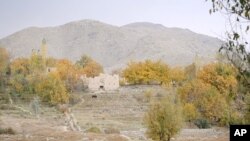Nine years after the fall of the Taliban, one of the regions in Afghanistan most damaged by 30 years of war is slowly coming back to life.
On Fridays many Kabulis pack into their cars and leave the traffic-jammed capital behind. They get on the Kabul-Mazar highway and head out about 20 kilometers to the Shomali Plain. Here they relax in vineyards, eat grapes, dried fruit and walnuts, and drink tea.
The stretch of land from Kabul to Shomali is some of the most fertile in Afghanistan. But the plains saw heavy fighting over the past 30 years, serving as a frontline first after the Soviet invasion and then under the Taliban years. Homes and farms were destroyed, large areas were littered with mines.
But things are changing.
Back to life
The one-lane highway is now two. Farmers have come back and replanted their vines. Residents say in the past few years they have again been able to rely on their land for food.
Ghyas, who works in Kabul, makes the commute from Shomali to the capital several times a week. His family has lived in the district of Gul Dara for generations.
Gul Dara means "valley of flowers" in Dari. Ghyas remembers what the plain was like before the Taliban.
He says it had everything: pears, apples, grapes, raisins, figs, apricots, peaches and cherries.
Taliban rule
Ghyas' father was killed when the Soviets invaded. He says when the Taliban took over in 1996 there was no work. He was scared he would have to fight so Ghyas and his mother left for Pakistan, where he wove carpets for $4 a day.
Most Shomali residents left during the Taliban years. They went to Pakistan or Iran. Shopkeeper Mama Nasier was an exception; he decided to stay and then was jailed by the Taliban. Nasier remembers the day he was taken from the front of his shop. Two years and six months later he got out.
Nasier says after his release from jail the situation was so bad that if he had taken pictures, people would not have believed that this was the valley of flowers. There were no trees, no houses, everything had burned. Not even birds were here, and even the shop had burned down. This place, Nasier says, was crazy.
Blessing or curse?
The Shomali Plain's location and its vineyards seem to have been both a blessing and a curse.
The Kabul-Mazar highway is the only road entering the capital from North and Central Asia. So whether it was the Soviet convoys lining the highway and the mujahideen attacking them from the vineyards or Taliban fighting the Northern Alliance from the capital, the area was prime for fighting.
An estimated 200,000 residents left Shomali between 1998 and 2000. When the U.S.-led foreign forces came in 2001, the United Nations started returning displaced villagers. Ghyas says that was the hardest time.
The return
He says when they came back, they did not have a house, so they had to put up a tent and live in it. The economy was not good, so they could not afford a house, they had to build one, so they were living outside. It has taken nine years to get where they are.
After nine years, residents say things here are much better but there is still not enough water, the irrigation canals and roads are in poor condition. But there is a school and a clinic.
The fruit-stall sellers say they are back to selling their produce to the Kabul bazaar, though the market is not good and it is hard to get decent prices for their grapes and apples.
As one seller speaks, another from the next stall says he can only sell fruit for 80 to 100 Afghanis a kilogram, roughly $2 -- much less than in previous years.
Good old days
The two talk back and forth about how they used to export fruit to Pakistan and India and raisins to Russia. They say the government has promised to start exports again but many think those are empty promises.
While many people in Shomali are optimistic about the future, they still fear that the Taliban may come back. They also complain that government corruption makes it harder for farmers who are bringing life back to the Shomali Plain.
After War, Afghan Plain Begins to Flourish
